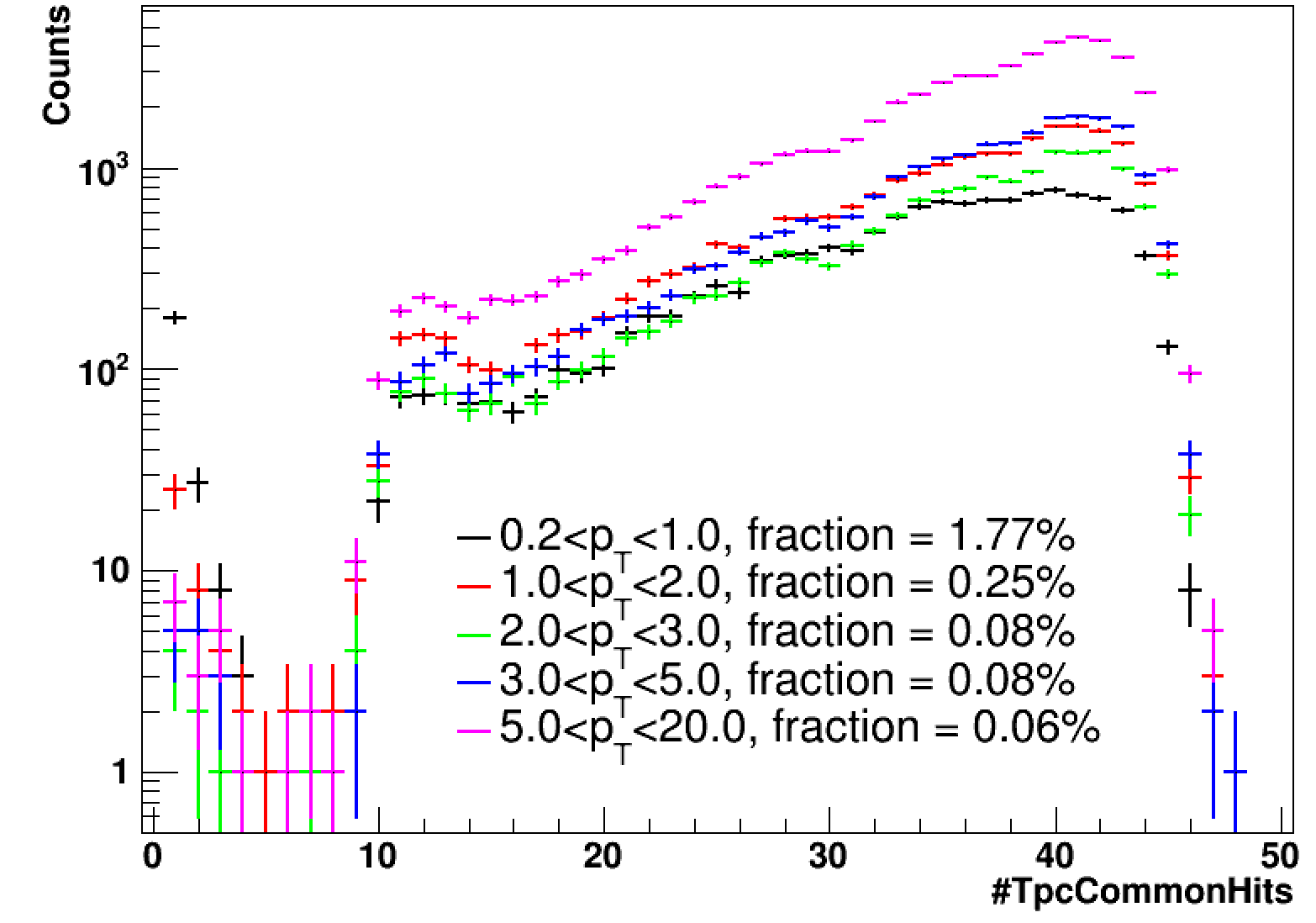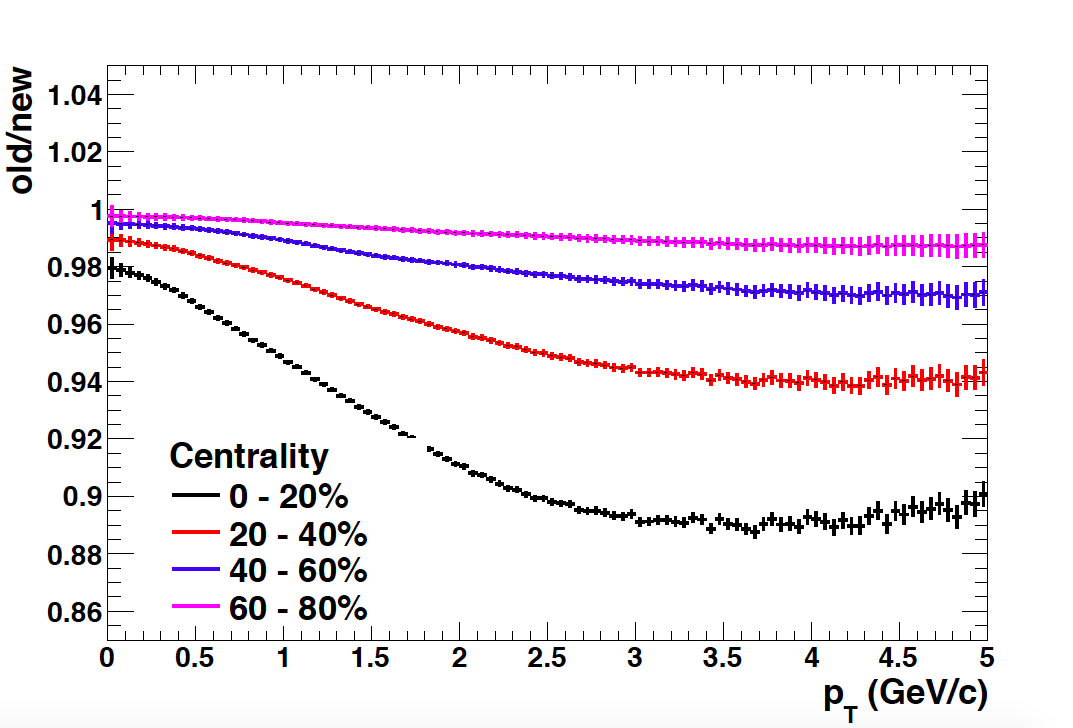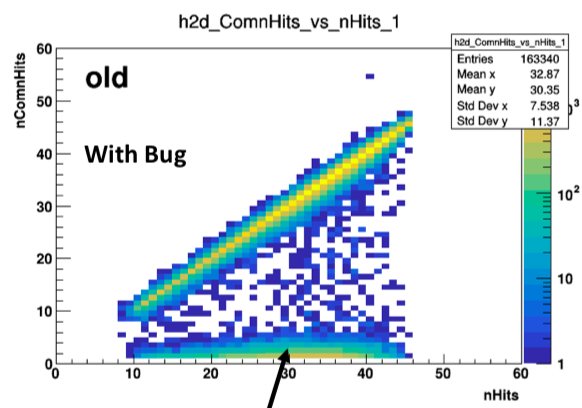- marr's home page
- Posts
- 2025
- March (1)
- 2023
- 2022
- October (1)
- 2019
- January (2)
- 2018
- November (1)
- October (1)
- September (1)
- August (1)
- May (2)
- April (5)
- March (1)
- February (1)
- January (1)
- 2017
- December (1)
- November (1)
- October (3)
- September (1)
- August (2)
- July (1)
- June (3)
- April (3)
- March (2)
- February (1)
- January (5)
- 2016
- 2015
- My blog
- Post new blog entry
- All blogs
Effect of matching between MC and RC tracks
Updated on Fri, 2019-01-11 13:49. Originally created by marr on 2019-01-11 08:58.
Recently, an issue was found by Zaochen and Shuai in terms of matching MC and RC tracks in the embedding.
The issue results from the combination of the following two factors:
- Setting required common hits for SVT and/or SSD to be 0 in the steering macro:

2. Jpsi BES paper (Phys. Lett. B 771 (2017) 13), low-pt Jpsi analysis
Data set: BES - 39, 62.4 GeV (2010), 200 GeV (2011); low-pt: 200 GeV (2010+2011)
The issue results from the combination of the following two factors:
- Setting required common hits for SVT and/or SSD to be 0 in the steering macro:
parameterDB->setReqCommonHitsSvt(0);
parameterDB->setReqCommonHitsSsd(0);
In the StAssociationMaker, a RC track is selected as a candidate matched with the MC track once the following requirement is fulfilled:
In the StAssociationMaker, a RC track is selected as a candidate matched with the MC track once the following requirement is fulfilled:
if (candidates[iCandidate].nPingsTpc >= parDB->reqCommonHitsTpc() ||
candidates[iCandidate].nPingsSvt >= parDB->reqCommonHitsSvt() ||
candidates[iCandidate].nPingsSsd >= parDB->reqCommonHitsSsd() ||
candidates[iCandidate].nPingsFtpc >= parDB->reqCommonHitsFtpc())
candidates[iCandidate].nPingsSvt >= parDB->reqCommonHitsSvt() ||
candidates[iCandidate].nPingsSsd >= parDB->reqCommonHitsSsd() ||
candidates[iCandidate].nPingsFtpc >= parDB->reqCommonHitsFtpc())
Consequently, the requirement of 10 common TPC hits is bypassed, and all the RC tracks with at least one common hit will be selected as a candidate.
- In user's analysis, the RC track with the largest number of nHitsFit is chosen to be the one matched with a given MC track. It could happen that a RC track with a large number of nHitsFit, but very small number of common TPC hits is selected. It is very likely that such a RC track is not originated from the MC track. To eliminate such cases, a cut of minimum 10 common TPC hits is applied in the use's analysis, resulting in an artificial decrease of TPC tracking efficiency.
This issue is found in several published results and ongoing analyses. Here is a collection of the evaluation of the effect from PAs.
Since the issue only manifests itself when there are other RC tracks present in the event as candidates, its effect is expected to increase with TPC occupancy. Therefore, one would expect the following aspects to play a role: collision system, collision energy, centrality, instantaneous luminosity, etc.
1. High-pt Jpsi RAA (Phys. Lett. B 722 (2013) 55 )
Data set: 2009 p+p, 2010 Au+Au (HT trigger)
Zebo: the following figure shows the distribution of number of common TPC hits for the matched RC tracks in different pt bins from 2009 p+p embedding data. Only |\etaMC| < 1 cut is applied, which is equivalent to |yMC|<1 for electron. The numbers shown in the legend is the fraction of track with common TPC Hits less than 10. For run9 analysis, the pt cut for EMC triggered electron is 2.5 (HT0) or 5 (HT3), for TPC electron is 1.0 (HT0) or 1.2 (HT3). So the effect is less than 0.33%.
- In user's analysis, the RC track with the largest number of nHitsFit is chosen to be the one matched with a given MC track. It could happen that a RC track with a large number of nHitsFit, but very small number of common TPC hits is selected. It is very likely that such a RC track is not originated from the MC track. To eliminate such cases, a cut of minimum 10 common TPC hits is applied in the use's analysis, resulting in an artificial decrease of TPC tracking efficiency.
This issue is found in several published results and ongoing analyses. Here is a collection of the evaluation of the effect from PAs.
Since the issue only manifests itself when there are other RC tracks present in the event as candidates, its effect is expected to increase with TPC occupancy. Therefore, one would expect the following aspects to play a role: collision system, collision energy, centrality, instantaneous luminosity, etc.
1. High-pt Jpsi RAA (Phys. Lett. B 722 (2013) 55 )
Data set: 2009 p+p, 2010 Au+Au (HT trigger)
Zebo: the following figure shows the distribution of number of common TPC hits for the matched RC tracks in different pt bins from 2009 p+p embedding data. Only |\etaMC| < 1 cut is applied, which is equivalent to |yMC|<1 for electron. The numbers shown in the legend is the fraction of track with common TPC Hits less than 10. For run9 analysis, the pt cut for EMC triggered electron is 2.5 (HT0) or 5 (HT3), for TPC electron is 1.0 (HT0) or 1.2 (HT3). So the effect is less than 0.33%.

2. Jpsi BES paper (Phys. Lett. B 771 (2017) 13), low-pt Jpsi analysis
Data set: BES - 39, 62.4 GeV (2010), 200 GeV (2011); low-pt: 200 GeV (2010+2011)
Wangmei: the figure shows the effect on Jpsi efficiency as a function of pt. For the low pt analysis (pT < 0.3 GeV/c), the effect is within 2%. The effect depends on centrality and pT of Jpsi. The effect for 40-80% is within 2%, for 20-40% is within 5%, for 0-20 is within 10%.

3. Jpsi cross-section in 500 GeV p+p collision
Data set: 2011 p+p 500 GeV
Qian: Here are the plots of common hits vs RC pT from p+p 500 GeV with the Svt and Ssd common hits setting to 0. As long as there is a matching between MC track and RC track, more than 99% of the RC track has a common hit larger than 10. So the svt and ssd common hits have a negligible effect on my analysis.

4. Jpsi cross-section in 200 GeV p+p collisions (Phys. Lett. B 786 (2018) 87)
Data set: 2012 200 GeV p+p collisions
5. Upsilon in 200 GeV Au+Au
Data set: Run11 200 GeV Au+Au
Zaochen: the effect for single track is 8.8%, and for quarkonium is 16.8%.


3. Jpsi cross-section in 500 GeV p+p collision
Data set: 2011 p+p 500 GeV
Qian: Here are the plots of common hits vs RC pT from p+p 500 GeV with the Svt and Ssd common hits setting to 0. As long as there is a matching between MC track and RC track, more than 99% of the RC track has a common hit larger than 10. So the svt and ssd common hits have a negligible effect on my analysis.

4. Jpsi cross-section in 200 GeV p+p collisions (Phys. Lett. B 786 (2018) 87)
Data set: 2012 200 GeV p+p collisions
5. Upsilon in 200 GeV Au+Au
Data set: Run11 200 GeV Au+Au
Zaochen: the effect for single track is 8.8%, and for quarkonium is 16.8%.

»
- marr's blog
- Login or register to post comments
